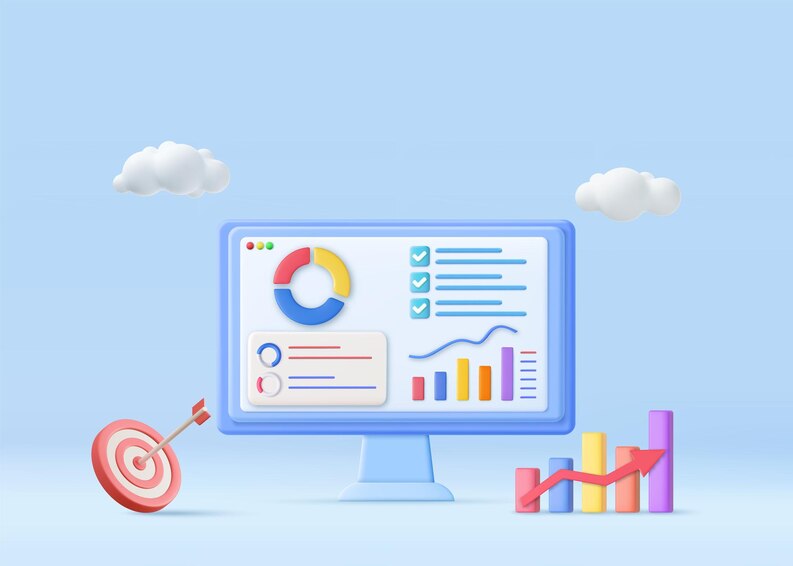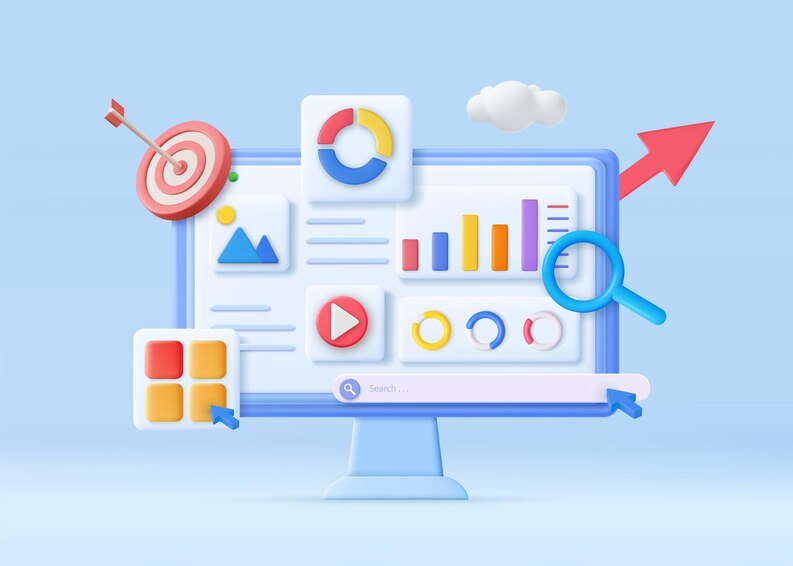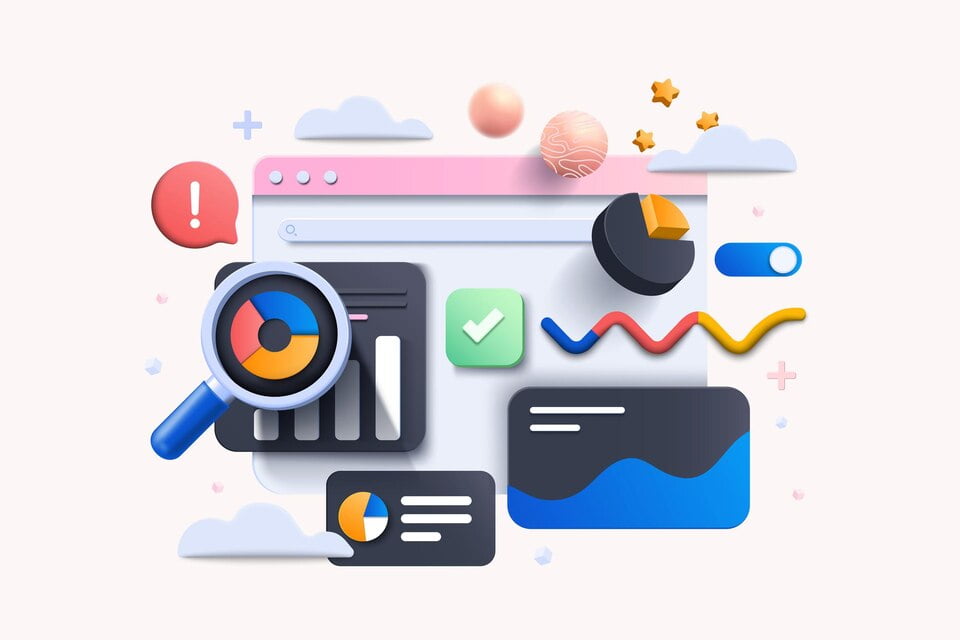If you’re looking to turn your raw data into actionable insights, data analytics software can help. With the increasing volume and complexity of data, businesses need advanced data analytics tools to extract valuable insights from it and gain a competitive advantage. Big data analytics software and data analytics tools empower enterprises to identify patterns, trends, and correlations in large datasets and turn them into meaningful information.
Data analytics software provides functionalities such as data integration, data cleaning, data modeling, data visualization, machine learning analytics, and predictive analytics software, to name a few. By leveraging business intelligence software, you can obtain insights that will take your business to the next level.
This article aims to explore various data analysis software available in the market, comprehensively evaluate their features, and provide practical tips on selecting and implementing the best-suited software for your organization. As we dive deeper into understanding the different data analytics software, its features, and benefits, we will showcase some success stories and discuss the future outlook for data analytics software.
Table of Contents
Understanding Data Analytics Software
Data analytics software is a vital tool that helps businesses transform raw data into actionable insights. It enables you to extract meaningful information from your data, to gain a competitive edge in the marketplace. Advanced data analytics techniques play a crucial role in the process, of uncovering patterns, trends, and correlations that might not be visible through simple data analysis.
Data analytics software employs a range of tools and algorithms to access and process various forms of data, from structured to unstructured and uses computational techniques to uncover hidden insights. These insights help decision-makers to make informed judgments and drive innovative ideas for the business.
Moreover, the software can assist businesses in identifying and rectifying issues within their data. By analyzing data over time, businesses can spot trends that signal problems. For instance, in the retail industry, analysis of sales data can reveal seasonal trends and predict a slump or unexpected growth, providing an opportunity to adjust inventory or marketing strategies in advance.
Overall, data analytics software is essential for businesses seeking to thrive in today’s data-driven landscape. By embracing advanced analytics techniques and analyzing data from various sources, businesses can improve efficiency and agility, delivering better products and services, and driving growth.
Key Features of Data Analytics Software

Data analytics software has become a crucial asset for businesses looking to stay competitive in today’s data-driven market. To ensure effective analysis, it is essential to select software that possesses a range of key features, including:
- Data integration: The ability to combine data from various sources into a single, comprehensive dataset that can be analyzed.
- Data cleaning: The ability to identify and eliminate inaccuracies, inconsistencies, and duplications in the data, ensuring that analysis is conducted using high-quality data.
- Data modeling: The ability to create mathematical models that can be used to predict future outcomes based on historical data.
- Data visualization tools: The ability to present data intelligibly and in a visually appealing way to help facilitate understanding, and promote informed decision-making.
| Feature | Product A | Product B | Product C |
|---|---|---|---|
| Data Integration | ✓ | ✓ | ✓ |
| Data Cleaning | ✓ | ✓ | |
| Data Modeling | ✓ | ✓ | |
| Data Visualization Tools | ✓ | ✓ | ✓ |
These features help facilitate an effective data analytics process, enabling companies to gain actionable insights, make informed decisions, and drive business growth.
Benefits of Data Analytics Software for Business
Effective data analysis is vital for businesses to drive growth and stay ahead in today’s data-driven landscape. With the help of data analytics software, organizations can unlock valuable insights and make informed decisions. Below are some of the significant advantages businesses can gain by utilizing data analytics software:
- Optimize operations: Data analytics software empowers businesses to optimize operations and improve overall efficiency by identifying bottlenecks, inefficiencies, and areas for improvement.
- Identify new revenue streams: By analyzing customer behavior, market trends, and other relevant data points, businesses can identify new revenue streams and diversify their offerings.
- Drive strategic decision-making: Data analytics software provides businesses with actionable insights that can guide strategic decision-making and enable them to stay ahead of the competition.
- Gain a competitive advantage: By leveraging big data analytics software and business intelligence software, businesses can gain a competitive advantage in the marketplace.
Overall, data analytics software enables businesses to uncover hidden patterns, trends, and correlations that can drive growth, enhance operations, and increase profitability. By choosing the right data analytics software and implementing it effectively, businesses can maximize the benefits of their data analytics initiatives and stay ahead of the curve.
Types of Data Analytics Software

When it comes to data analytics software, there are several types available for businesses to choose from. In this section, we will focus specifically on predictive analytics software and how it can provide valuable insights into future trends, customer behavior, and market dynamics.
Predictive Analytics Software
Predictive analytics software utilizes algorithms and models to analyze historical data and uncover patterns that can be used to make predictions about future outcomes. This type of software can provide significant benefits for businesses looking to stay ahead of the competition by anticipating trends and making proactive decisions.
With predictive analytics software, businesses can:
- Forecast future sales and revenue
- Identify potential risks and opportunities
- Optimize marketing and advertising strategies
- Improve operational efficiency
Some popular predictive analytics software options include IBM SPSS, SAS Predictive Analytics, and RapidMiner.
Tip: When selecting predictive analytics software, consider the level of technical expertise required to operate the software, as well as the cost and support options available.
By utilizing predictive analytics software, businesses can gain a competitive advantage in today’s fast-paced and data-driven business landscape. Stay ahead of the curve by incorporating predictive analytics software into your data analytics strategy.
Data Visualization Software
Data visualization software plays a crucial role in the data analytics process, as it transforms raw data into clear, easy-to-understand visual representations. With data visualization tools, you can create informative charts, graphs, and interactive dashboards that enable you to quickly identify trends, patterns, and anomalies in your data.
Effective data visualization can help you make more impactful, data-driven decisions, as it allows you to easily identify opportunities and potential areas of improvement. By incorporating data visualization software into your data analytics process, you can streamline data exploration, enhance communication, and drive business growth.
There are various data visualization software available in the market, ranging from simple chart-building tools to more robust platforms with sophisticated data visualization capabilities. Some popular data visualization software include Tableau, QlikView, and Microsoft Power BI. Before selecting a data visualization tool, it is crucial to evaluate your specific business needs and data requirements to ensure you choose the right solution for your organization.
Incorporating Machine Learning in Data Analytics

In today’s era of big data, organizations collect vast amounts of data that need to be analyzed to uncover hidden insights. However, traditional data analysis methods may struggle to handle large volumes of data and identify complex patterns. This is where machine learning comes into play. Machine learning algorithms can be integrated into data analytics software to automate data processing, identify patterns, and generate accurate predictions, making data analysis faster and more efficient.
Machine learning algorithms use statistical models as a basis for decision-making, and the more data they analyze, the more accurate predictions they can make. Therefore, the more data your organization has, the more valuable machine learning algorithms become.
How machine learning works in data analytics software:
| Step | Description |
|---|---|
| Data Preprocessing | The data is cleaned and transformed into a format that machine learning algorithms can read. |
| Training | The algorithm is trained using sample data to learn patterns and relationships within data. |
| Testing | A portion of the data is used to test the algorithm’s accuracy and refine it further if necessary. |
| Prediction | The algorithm is applied to new data to generate predictions based on learned patterns and relationships. |
Integrating machine learning algorithms into data analytics software empowers businesses to gain actionable insights, make data-driven decisions, and drive strategic growth. Whether you are analyzing customer behavior, identifying market trends, or optimizing operations, machine learning analytics is a powerful tool for unlocking the full potential of your data.
Choosing the Right Data Analytics Software
With numerous options available in the market, selecting the appropriate data analytics software for your organization can be a daunting task. To make an informed decision, consider the following essential factors:
Scalability
Ensure that the software can handle large datasets and can be easily upgraded as your business grows.
Ease of Use
Your team should be able to use the software without requiring extensive training. Look for software with a user-friendly interface and intuitive navigation.
Integration Capabilities
Select software that can integrate with your existing systems and tools, eliminating the need for manual data processing, and saving time.
Support and Maintenance Options
Choose software that provides timely technical support, regular updates, and maintenance services. These are critical for the continuous smooth operation of the software.
| Software | Scalability | Ease of Use | Integration | Support |
|---|---|---|---|---|
| Tableau | High | Easy | Multiple (including Salesforce, SAP, and Azure) | Excellent |
| QlikView | High | Easy | Multiple (including SAP, Oracle, and Salesforce) | Good |
| Microsoft Power BI | High | Easy | Multiple (including Dynamics 365, Excel, Google Analytics) | Good |
Popular data analytics software options include Tableau, QlikView, and Microsoft Power BI. Each has its unique set of features and capabilities, so evaluate them based on your priorities and requirements. Always opt for software that offers scalability, ease of use, integration capabilities, and robust support and maintenance options. This will help you optimize the potential of your data analytics software and enable your organization to make informed decisions, drive profitable growth, and gain a competitive edge.
Implementing Data Analytics Software: Best Practices
Implementing data analytics software can be an overwhelming process. However, by following these best practices, you can ensure a smooth and successful implementation:
Define Your Objectives
Before you start implementing data analytics software, define the goals and objectives of your analytics projects. Consider which data sources you will use, what insights you expect to uncover, and how data analytics will impact your business. Having clear objectives will help you select the right analytics tools and align your analytics initiatives with your overall business strategy.
Ensure Data Quality
Data quality is critical in data analytics. Ensure that the data you will be using is relevant, complete, and accurate by having a data quality plan in place. Perform data profiling and data cleansing to identify inconsistencies and data errors. By having clean data, you will gain more reliable and accurate insights and minimize the risk of making wrong decisions.
Secure Your Data
Data security is another critical aspect of data analytics. Ensure that the data you will be using is secure and complies with any regulatory requirements. Consider using encryption, role-based access control, and multi-factor authentication to protect your data from unauthorized access and cyber-attacks.
Foster a Data-Driven Culture
A data-driven culture is essential to ensure that data analytics initiatives receive the support they need to succeed. Engage stakeholders across your organization and educate them on the value of data analytics. Encourage collaboration and transparency and reward data-driven decision-making.
Choose the Right Data Analytics Tools
Selecting the right data analytics tool is crucial to the success of your analytics initiatives. Consider factors such as ease of use, scalability, integration capabilities, and support and maintenance options when choosing a data analytics software. Also, ensure that your analytics tools can accommodate your data types, volumes, and structures.
Implementing data analytics software requires planning, preparation, and attention to detail. However, by following these best practices, you can ensure that your analytics initiatives deliver reliable, actionable insights that drive better decision-making and business outcomes.
Case Studies: Success Stories with Data Analytics Software
Real-world examples demonstrate the benefits of data analytics software. The implementation of these tools has enabled several organizations to achieve remarkable success by unlocking hidden insights within their data. Let’s explore some success stories.
Company A – Streamlining Operations with Data Analytics
Company A, a retail giant, struggled with the complexities of managing a vast supply chain network. They turned to big data analytics software to help streamline their operations. By gathering data from suppliers, logistics teams, and inventory records, they were able to gain a 360-degree view of their supply chain. The software enabled them to identify areas for improvement, such as managing inventory better and speeding up delivery times. By implementing the recommended changes, they increased efficiency and reduced costs, resulting in increased profits.
Company B – Enhancing Customer Experience with Business Intelligence
Company B, a service-based business, relied on customer feedback to drive improvements in their offerings. However, they found it challenging to gather feedback from their clients effectively. They implemented business intelligence software to gather and analyze customer feedback data. The software helped them identify areas where clients were satisfied and areas where they could improve. By using their clients’ feedback to make targeted improvements in their services, they were able to increase positive customer experiences and overall customer satisfaction rates.
Company C – Identifying New Revenue Streams with Predictive Analytics
Company C, a telecommunications company, faced fierce competition from industry peers. They needed to improve their business model to stay ahead of the game. They implemented predictive analytics software to analyze customer data, including usage statistics and demographics. The software helped them predict future trends, identify customer preferences, and anticipate new revenue streams. The insights gained enabled the company to develop new products and services that better met their client’s needs, resulting in increased market share and revenue.
Company D – Visualizing Data for Better Decision-Making
Company D, a food manufacturing company, struggled with making data-driven decisions. They implemented data visualization software, which enabled them to create visual graphs and charts to represent their data actively. This software allowed them to identify critical trends and patterns easily, leading to better decision-making. By using the software to track metrics such as production run rates and quality control data, they were able to increase efficiency and quality, resulting in improved profits.
In conclusion, the above real-world examples demonstrate how big data analytics software, business intelligence, and predictive analytics can improve efficiency, increase profits, and enhance overall customer satisfaction rates. Whether you’re looking to streamline operations or identify new revenue streams, data analytics software can help you achieve your business goals.
Trends and Future of Data Analytics Software
Data analytics software is at the forefront of unlocking hidden insights that drive business growth. However, the future of data analytics and its potential impact on businesses is constantly evolving.
One emerging trend is the integration of advanced data analytics with artificial intelligence (AI). By leveraging machine learning algorithms, data analytics software can make more accurate predictions and provide more personalized insights into customer behavior and preferences. In addition, the adoption of cloud computing has enabled data analysts to access and analyze massive datasets from any location, increasing the speed and efficiency of data analysis.
The rising popularity of edge analytics, which allows data analysis to be performed closer to the source data rather than in a centralized database, is another trend that is gaining momentum. Edge analytics can help organizations reduce latency and improve the reliability of data analysis, important factors for industries such as manufacturing and healthcare.
Looking ahead, the future of data analytics software will be characterized by even greater adoption and integration of machine learning, predictive analytics, and AI capabilities. Furthermore, the integration of data analytics software with business intelligence tools will enable organizations to gain a holistic view of their operations and make more informed strategic decisions.
Table: Key Trends in Data Analytics Software
| Trend | Description |
|---|---|
| Integration with AI and machine learning | Data analytics software is increasingly incorporating AI and machine learning capabilities to provide more accurate predictions and insights. |
| Cloud computing | Cloud-based data analytics software is allowing companies to access and analyze massive datasets from anywhere, increasing the speed and efficiency of data analysis. |
| Edge analytics | Edge analytics allows data analysis to be performed closer to the source data, reducing latency and improving the reliability of data analysis. |
| Integration with business intelligence software | The integration of data analytics software with business intelligence tools enables organizations to gain a more comprehensive view of their operations and make more strategic decisions. |
Conclusion
In conclusion, choosing the right data analytics software is critical for unlocking valuable insights and driving strategic growth in your organization. By leveraging advanced data analytics tools such as big data analytics software, predictive analytics software, and business intelligence software, you can optimize your operations, identify new revenue streams, and gain a competitive advantage in today’s data-driven business landscape.
When implementing data analytics software, it’s important to follow best practices such as ensuring data quality and security, fostering a data-driven culture, and providing adequate training to your team. By doing so, you can maximize the benefits of your data analytics initiatives and avoid common pitfalls.
Looking to the future, the trend toward advanced data analytics, artificial intelligence, and cloud computing will continue to shape the evolution of data analytics software. As technology continues to evolve, businesses that stay ahead of the curve in utilizing data analytics software will be better equipped to harness the power of data for future success.




